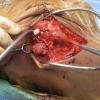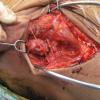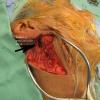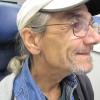Click on image above to enlarge; adavance with cursor over border
return to: Parotidectomy with Facial Nerve Dissection
External ear innervation
Auriculotemporal (CN V)-- superior and external part of the ear and anterior ear canal; Inject anesthetic superiorly and anteriorly to the tragus
Great auricular nerve (C2, C3)-- inferior part of the ear both surfaces; Inject on posterior sulcus
Auricular branch of vagus (CN X)-- concha and posterior ear canal
CN VII and IX also contribute to the concha and ear canal
Tail of parotid 1.3 cm pleomorphic adenoma resected with clear margins. Note retrograde dissection of the facial nerve permitted limiting the extent of the skin incision and parotid dissection.
(click on photos to enlarge and advance to next photos by placing cursor over right mid border and clicking on arrow that will appear)
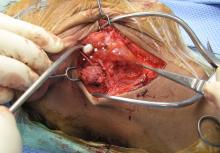 |
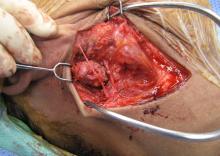 |
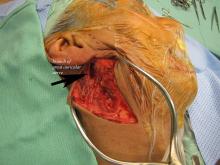 |
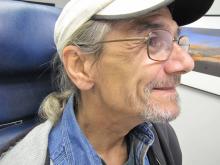 |
|
note retrograde dissection of facial nerve (marked by stars) permits resection of tail of parotid without pre-auricular incision. Also note great auricular nerve overlying benign tumor |
great auricular nerve is dissected free without compromising margins |
resection complete with preservation of great auricular nerve |
3 months post-op with sensation returning to ear |
Although anterior branches of the great auricular nerve generally need to be severed to perform even a limited parotidectomy, the posterior branch(es) are usually preserved. The dissection adds time to the procedure but is generally felt to be worth it by improving the chance of return of sensation to the ear lobe (usually after 6 months) and providing a cable graft nerve available at some point the future were it needed.
The great auricular nerve should not be preserved if doing so increases the chance of tumor recurrence (compromising a margin).
Three months postop the patient returns with sensation beginning to return to the earlobe. Near-normal sensation is expected at one year postop.
